Description
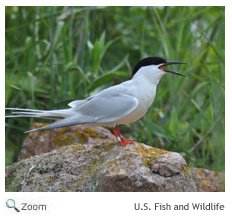 The roseate tern is a graceful, slender, medium-sized tern. It is
14-17
inches in length with a wingspan of
29-32 inches. It has a long, sharp, black bill and a long, forked, white tail. During breeding season, it has a black cap, a silvery-gray back, and a white breast and belly lightly tinged with pink.
Its legs and feet are a bright reddish-orange. In non-breeding season, its tail is shorter and its legs and feet are black. It has a white forehead and a black cap on the back of its head. Males and females look alike. The roseate tern is a graceful, slender, medium-sized tern. It is
14-17
inches in length with a wingspan of
29-32 inches. It has a long, sharp, black bill and a long, forked, white tail. During breeding season, it has a black cap, a silvery-gray back, and a white breast and belly lightly tinged with pink.
Its legs and feet are a bright reddish-orange. In non-breeding season, its tail is shorter and its legs and feet are black. It has a white forehead and a black cap on the back of its head. Males and females look alike.
Range  The roseate tern breeds along the Atlantic Coast from Nova Scotia, Canada south to New York. It also breeds in the Florida Keys. It winters along the coast of South America. It is also found in the Caribbean, Europe, the Indian Ocean, South Africa, and Western Australia. The roseate tern breeds along the Atlantic Coast from Nova Scotia, Canada south to New York. It also breeds in the Florida Keys. It winters along the coast of South America. It is also found in the Caribbean, Europe, the Indian Ocean, South Africa, and Western Australia.
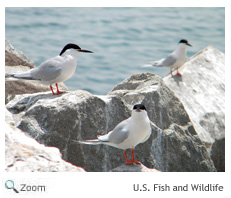 In New Hampshire, the roseate tern breeds on the Isles of Shoals.
They return to the islands in April and May. In 1997, the
Audubon Society of New Hampshire and the NH Fish and Game Department
began creating safe nesting sites for the common tern on White and Seavey Islands. The safe nesting sites use decoys and other non-lethal tools to drive away sea gulls! The safe nesting habitat has attracted not just the common terns, but also the roseate tern and even the arctic tern. The number of roseate tern pairs nesting in the Isles of Shoals has grown from 1 pair in 2001 to as many as 112 pairs in 2004 and 40 pairs in 2008. In New Hampshire, the roseate tern breeds on the Isles of Shoals.
They return to the islands in April and May. In 1997, the
Audubon Society of New Hampshire and the NH Fish and Game Department
began creating safe nesting sites for the common tern on White and Seavey Islands. The safe nesting sites use decoys and other non-lethal tools to drive away sea gulls! The safe nesting habitat has attracted not just the common terns, but also the roseate tern and even the arctic tern. The number of roseate tern pairs nesting in the Isles of Shoals has grown from 1 pair in 2001 to as many as 112 pairs in 2004 and 40 pairs in 2008.
Habitat 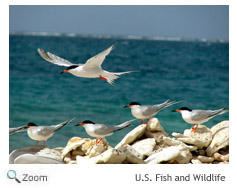 The roseate tern breeds on rocky, coastal islands; barrier beaches; and salt marsh islands. It winters offshore or along coasts. The roseate tern breeds on rocky, coastal islands; barrier beaches; and salt marsh islands. It winters offshore or along coasts.
|
|
Diet
The roseate tern dives into the water and catches small fish. It also eats some invertebrates.
Life Cycle 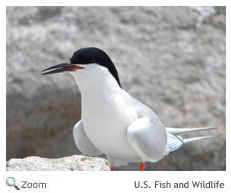 The male roseate tern often courts a female by flying overhead in circles with a fish in his bill! The roseate tern nests in colonies, often with common terns. The nest is a scrape in the ground and is sometimes lined with
grass and other debris.
The nest is usually placed under the cover of rocks or vegetation. The female lays 1-4 eggs and both the male and the female incubate the eggs for 23-24 days. Both parents feed and care for the chicks. The chicks leave the nest a few days after hatching, but they will continue to be fed and cared for by their parents until they fledge when they are 25-28 days old. The male roseate tern often courts a female by flying overhead in circles with a fish in his bill! The roseate tern nests in colonies, often with common terns. The nest is a scrape in the ground and is sometimes lined with
grass and other debris.
The nest is usually placed under the cover of rocks or vegetation. The female lays 1-4 eggs and both the male and the female incubate the eggs for 23-24 days. Both parents feed and care for the chicks. The chicks leave the nest a few days after hatching, but they will continue to be fed and cared for by their parents until they fledge when they are 25-28 days old.
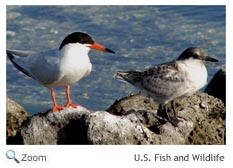 About 70-75 percent of a roseate tern population will return to the same nesting site each year. Scientists aren't sure why the remaining birds fail to return. They think it could be that the birds have died during migration, been killed by hunters in their wintering grounds in South America, been killed by a predator, or have simply chosen another nesting site. About 70-75 percent of a roseate tern population will return to the same nesting site each year. Scientists aren't sure why the remaining birds fail to return. They think it could be that the birds have died during migration, been killed by hunters in their wintering grounds in South America, been killed by a predator, or have simply chosen another nesting site.
Behavior
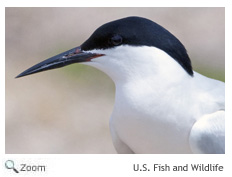 In the late 1800s, the roseate tern was hunted for its feathers, which were used to decorate ladies hats. The
Migratory Bird Treaty Act of 1918 protected birds like the roseate tern and its number began to recover in the 1920s and 1930s.
The recovery didn't last long, and by the 1950s the roseate tern had disappeared from much of the Northeastern United States, including New Hampshire. The drop was due to loss of habitat, competition for habit, and predation. The roseate tern was placed on the Federal Endangered Species list in 1987 and is an endangered species in New Hampshire. In the late 1800s, the roseate tern was hunted for its feathers, which were used to decorate ladies hats. The
Migratory Bird Treaty Act of 1918 protected birds like the roseate tern and its number began to recover in the 1920s and 1930s.
The recovery didn't last long, and by the 1950s the roseate tern had disappeared from much of the Northeastern United States, including New Hampshire. The drop was due to loss of habitat, competition for habit, and predation. The roseate tern was placed on the Federal Endangered Species list in 1987 and is an endangered species in New Hampshire.
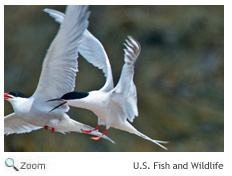 The roseate tern nests on beaches and is easily disturbed. If a beach is used by people, it may abandon its nesting site. It has also lost habitat due to competition for food and nesting sites from larger and more aggressive birds like the
black-backed gull and the American herring gull.
Birds like
owls, gulls, and raptors prey on adult roseate terns and their chicks and eggs and can seriously harm a nesting population. The roseate tern nests on beaches and is easily disturbed. If a beach is used by people, it may abandon its nesting site. It has also lost habitat due to competition for food and nesting sites from larger and more aggressive birds like the
black-backed gull and the American herring gull.
Birds like
owls, gulls, and raptors prey on adult roseate terns and their chicks and eggs and can seriously harm a nesting population.
|

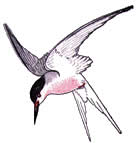

 The roseate tern breeds along the Atlantic Coast from Nova Scotia, Canada south to New York. It also breeds in the Florida Keys. It winters along the coast of South America. It is also found in the Caribbean, Europe, the Indian Ocean, South Africa, and Western Australia.
The roseate tern breeds along the Atlantic Coast from Nova Scotia, Canada south to New York. It also breeds in the Florida Keys. It winters along the coast of South America. It is also found in the Caribbean, Europe, the Indian Ocean, South Africa, and Western Australia. 




